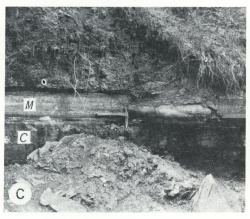Colchester Coal Member
Lithostratigraphy: Kewanee Group >>Carbondale Formation >>Colchester Coal Member
Chronostratigraphy: Paleozoic Erathem >>Pennsylvanian Subsystem >>Desmoinesian Series
Allostratigraphy: Absaroka Sequence
Primary source
Willman, H. B., Elwood Atherton, T. C. Buschbach, Charles Collinson, John C. Frye, M. E. Hopkins, Jerry A. Lineback, and Jack A. Simon, 1975, Handbook of Illinois Stratigraphy: Illinois State Geological Survey Bulletin 95, 261 p.
Contributing author(s)
M. E. Hopkins and J. A. Simon
Name
Original description
The Colchester (No. 2) Coal Member of the Carbondale Formation was designated No. 2 by Worthen (1866, p. 59) for the coal in a mine shaft at Highland, Madison County.
Derivation
Other names
The coal has also been called the La Salle (No. 2) Coal or the "Third Vein" coal in northern Illinois.
History/background
Worthen also used the name Colchester for the same coal at Colchester, McDonough County (1868, p. 11), and also (1870, p. 96-97) for an exposure 1.5 miles west of Vermont, Fulton County.
Type section
Type location
Wanless (1956, p. 10) designated exposures near Colchester as the type section (12, 13, 5N-4W).
Type author(s)
Type status
Reference section
Reference location
Reference author(s)
Reference status
Stratigraphic relationships
The Colchester Coal Member is the lowest member of the Carbondale Formation. It is overlain directly by either the black Mecca Quarry Shale Member, or, in parts of western and most of northern Illinois, by the gray Francis Creek Shale Member. It is underlain by a well developed underclay.
Extent and thickness
It is very extensive in Illinois and is thought to be one of the most widespread coals in the United States. It is generally thin, varying from a fraction of an inch to 18 inches in southern, central, and eastern Illinois, and is rather uniformly 2-3.5 feet thick throughout much of northern and western Illinois, where it has been extensively mined.
Lithology
The Colchester Coal is a normal, bright-banded coal (fig. P-3C).
Core(s)
Photograph(s)
Contacts
Well log characteristics
Fossils
Age and correlation
It is correlated with the Croweburg coal of Missouri and Kansas, the Schultztown of western Kentucky, the Broken Arrow or Croweburg of Oklahoma, the Whitebreast of Iowa, the Colchester Coal Member (IIIa) of Indiana, and tentatively with the Lower Kittanning Coal of the Appalachian field (Wanless, 1957).
Environments of deposition
Economic importance
Remarks
References
WANLESS, H. R., 1956, Classification of the Pennsylvanian rocks of Illinois as of 1956: Illinois State Geological Survey Circular 217, 14 p.
WANLESS, H. R., 1957, Geology and mineral resources of the Beardstown, Glasford, Havana, and Vermont Quadrangles: Illinois State Geological Survey Bulletin 82, 233 p.
WORTHEN, A. H., 1866, Geology: Geological Survey of Illinois, v. 1, 504 p.
WORTHEN, A. H., 1868, Geology and paleontology: Geological Survey of Illinois, v. 3, 574 p.
WORTHEN, A. H., 1870, Geology and paleontology: Geological Survey of Illinois, v. 4, 508 p.
ISGS Codes
| Stratigraphic Code | Geo Unit Designation |
|---|---|
